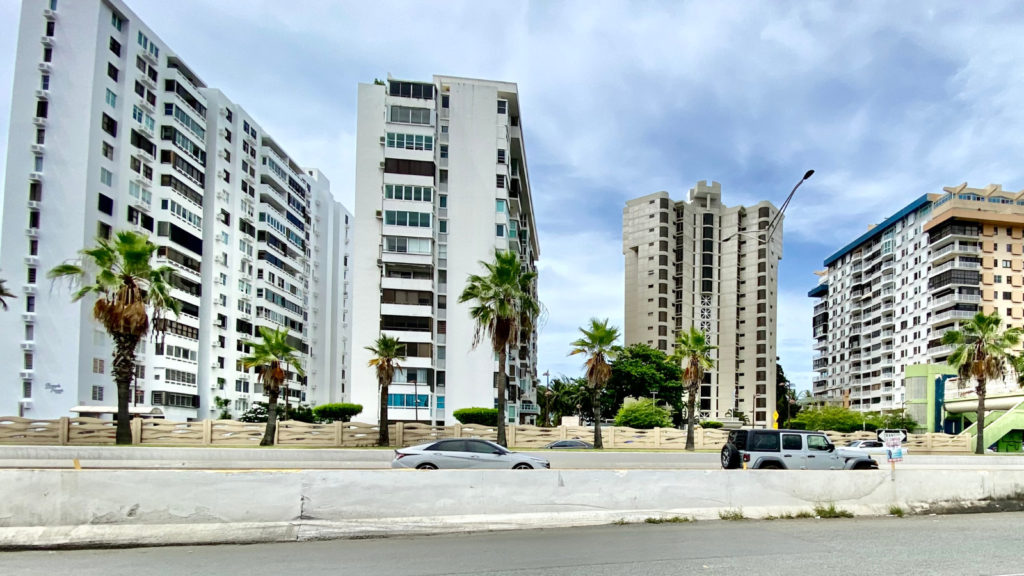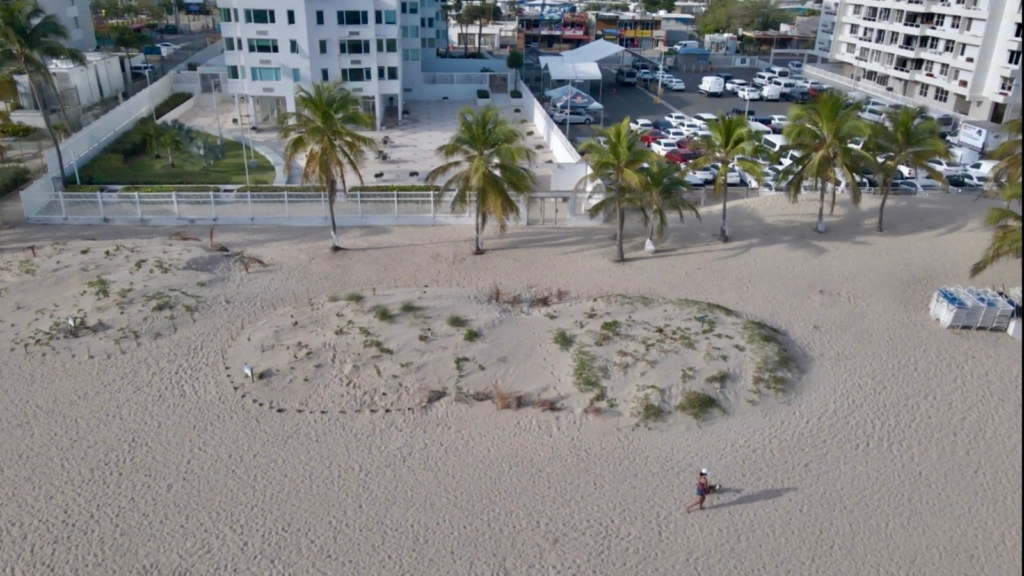As you walk along Isla Verde Avenue, just minutes from the Luis Muñoz Marín International Airport in San Juan, you can feel the breeze and the smell of salt water. Although the beach is nearby, a wall of buildings, spanning across 3 kilometres of road, prevents you from seeing the shoreline. When you reach Punta Las Marías, there is a coastal forest filled with sea grapes, as well as almond, pine, palm and icaco trees, resisting overdevelopment in the area. The nearly five acres of forest are a window to the sea, a conservation project that allows us to visualise what the entire coastline used to look like.
Environmental restoration is the focus of organisations such as the Coalition for the Restoration of Santurcean Ecosystems (CRES, in Spanish), the entity that planted native trees to recover the forest at Punta Las Marías.
As Puerto Rico became more urbanised in the 1940s, coastal constructions blocked people’s view, access and enjoyment of the beach. Avenues, hotels and residential developments, covered with cement what was once a palm grove. The land adopted by CRES, ironically, is one of the few remaining green areas on Isla Verde (which translates to “Green Island”, in English).

CRES restores the coast through two methods: adaptation measures and nature-based solutions. Adaptation involves, for example, creating breakwaters with rocks or gabions to counteract erosion, while nature-based solutions are known as green infrastructure, and involve planting native trees or plants. This type of “green infrastructure” promotes geotherapy, in which people can use the land as a therapeutic and healing remedy, said the organisation’s executive director, Yvette Núñez Sepúlveda.
“What we’re talking about is climate justice for people, without the need for a million-dollar investment in a lot of heavy machinery, which is unnecessary,” the urban planner explained.
In 2023, the organisation and its volunteers sowed 1,200 plants to progressively reforest the coastal forest of Punta Las Marías, according to data provided by CRES. In addition, they managed to remove 20,000 pounds of pollutants from the beach, with the help of 1,570 students and their families.
CRES also teaches communities about the coast that surrounds them and the importance of preservation. Núñez Sepúlveda explained that beach profiles and censuses of flora and fauna are an example of how citizens can recover spaces for community enjoyment.
Community management represents an alternative to the high costs of restoration work. “The idea is that the communities themselves know the benefits provided by the type of restoration in process. Sometimes, there is no need to spend large amounts of money on governments; people can participate in these processes,” she said.

She identified government bureaucracy and the criminalization of these community-led projects on the coast as limitations. Regulations require them to have permits to plant native trees in the maritime terrestrial zone. CRES applies for the permits, according to Núñez Sepúlveda, but the Department of Natural and Environmental Resources (DRNA, in Spanish) delays the approval or simply does not approve them.
“We met with the Isla Verde condominium boards to design the restoration of the dunes along more than a mile of coastline, but without the permits, we can’t do the work,” she said.
One of the dune restoration projects, in which CRES collaborated, was organised with the Playablanca Condominium Board of Directors in Isla Verde. Since 2017, the consequences of coastal erosion began to knock on their doors: due to the lack of dunes near the coast, sand accumulated near the condominium in a way that the gates to access the building would not close. This created a security problem, and when they contacted the DRNA, they understood that they needed the help of an organisation with expertise in the restoration of ecological areas.
For this reason, the community began collaborating with CRES and the organisation Arrecifes Pro Ciudad to restore the beach dunes and reforest the area with native plants. Six years after they began, they have restored some of the dunes and reforested part of the area. However, they have not been able to maintain the area because the DRNA has not yet granted the necessary permit to move sand and plant trees.
According to Antonio Marrero, former president of the Board of Directors of the Playablanca Condominium, they always had the required DRNA permits, but were unaware that these documents expired and had to be renewed. During their visit to the area, some DRNA officials congratulated the community for their project, but the agency still has not responded to their request for a new permit, which was sent by the Board a year ago, on September 6, 2023, he said.
Without this authorisation, organisations such as CRES cannot carry out their work without risking fines or legal action from government agencies.
Reviving San Juan’s coastal ecosystems
For the past ten years, CRES has supported the communities in the town formerly known as San Mateo de Cangrejos, which stretched from Loíza to San Juan, by cleaning up bodies of water, as well as reforesting mangroves and coastal trees, especially in sectors such as Playita. “These communities receive tons of waste that does not belong to them… They get all the waste from urban areas; all the sewage. There is no control or respect for the water here, in this area, and the communities there are vulnerable,” said Núñez Sepúlveda.
One of the communities in this area is the Cantera Peninsula, located in a system of lagoons and natural canals, that’s also part of the largest wetland in the Puerto Rican archipelago, the San Juan Bay Estuary.
The Cantera Peninsula has more than 7,000 inhabitants and is made up mostly of women heads of households with their children, and older adults. Seventy-four per cent of its population is below the federal poverty rate, according to the 2012 Census. According to reports from the Integral Development Corporation for Cantera, several of its sectors still lack access to essential services, such as electricity and drinking water.
.jpeg)
The Water Quality Monitoring Program, managed by San Juan Bay Estuary Volunteers, shows that the water quality of the rivers and creeks, in the estuarine basin, contained waste and contaminants such as fecal coliform, enterococci, oils and fats, in samples taken between 2008 and 2018. The impact on water quality responds to the discharge of used and untreated water, which they receive daily.
However, the community has promoted initiatives to manage the nature reserve. The director of the Business Support Program for the Cantera Peninsula, Carlos García, explained that they are working on a community ecotourism project under the name Peninsula Expeditions.
“The interpretive tour is based on the natural, historical and cultural heritage of this area, meaning the flora, fauna, and the development of the community, the historical and social dynamics in the communities, how these communities were established, the value of the birds and the conservation of the habitats themselves,” Garcia explained.
The restoration also brings benefits to the economic development of the community. “It’s a wonderful place with excellent natural resources. We want to embolden our community… To continue moving towards being a resilient and self-sufficient community,” explained Gertrudis Calderón, a community leader, born and raised in Cantera. The group’s ambition is to develop a café-restaurant and audiovisual lounge, managed by the Neighborhood Council.
CRES also collaborates with Cantera on projects such as the Bravos de Boston community garden and activities such as coastal cleanups, environmental fairs and a butterfly garden to conserve the monarch..
Cantera is just one example of the communities that CRES supports with the resources and knowledge necessary to care for their local ecosystems.
“We work mainly with education. So that the communities know, for example, how they can work on a beach profile,” explained Núñez Sepúlveda. Beach profiles attempt to measure the slope and width of a beach. This process shows how the coast is eroding or how the tide is rising. CRES takes photographs and videos and identifies seabirds, to strengthen these efforts.
“I really believe in empowering people with the right tools, which are always tools based on natural knowledge: that we observe what is around us; how it works, how it works best and when it has been at its best. Observing the ecosystem and interacting with the ecosystem; we are committed to that connection. Learning through experience,” said Núñez Sepúlveda.

Community-led reef restoration
As part of its work, CRES collaborated with Arrecifes Pro Ciudad to identify and restore the San Juan Reef, which is currently the largest metropolitan and urban reef in Puerto Rico. “That’s dead,” some people initially told them. Through photos, videos, geolocation points and fish censuses, they proved that there is habitat there for dozens of species of flora and fauna, Núñez explained.
The organization has used a “Biorock” technique, which uses metallic materials and low-voltage electrical wiring to increase the amount of minerals and stimulate coral growth. This technique has made the reef reduce the force of the waves on the beach, favouring the proper accumulation of sand. Coral regeneration also protects coastal communities to make them more resistant to storms and prevents increased beach erosion.
CRES has also been working with Arrecifes Pro Ciudad on the design, management and restoration of Isla Verde’s dunes, and the protection of turtle nests. The dunes function as natural barriers to weather events, and function as a habitat for vulnerable or critically endangered species.
“Our goal is not only to restore the dunes but to create a model of sustainable coastal management,” explained Núñez Sepúlveda. Through their efforts, they not only restore habitat for native wildlife but also create a space for the enjoyment of residents. So far, the project has succeeded in reintroducing native vegetation and stabilising the dunes to prevent erosion, which has attracted turtles to once again use this beach as a nesting area.
CRES also participates in the Bucaré Urban Garden community garden and nursery, located near the coastal forest. There, plant species are sown and grown, which are then transplanted into the forest. Originally an empty house, it was donated by a family 20 years ago, so that it could be used as a garden by the community. It has also been CRES’ administrative space for the last 10 years.
However, CRES’ work is not limited to Santurce, Cantera and Punta Las Marías. Núñez Sepúlveda emphasised the role of collaboration in its efforts, deeming partnerships with community groups and international volunteers as essential. In this way, CRES supports the reforestation of native and endemic trees on the coast of other municipalities, such as Yabucoa and Guayanilla.
On the island of Culebra, they collaborate with the organisation Mujeres de Islas in community composting projects and natural agricultural education initiatives. In just one year, they were able to divert 15,000 pounds of organic matter from landfills, produced by 21 businesses near a rescued school where they work. This pilot program has been ongoing for five years. They also created a butterfly garden for the community.
“We have worked a lot on natural or ancestral agriculture. There, they have taken many ancestral seeds such as cassava,” explained Núñez.
“Many times we include the older people of the community in these conversations because they have a lot of knowledge of the plants, the problems and the results. It is a pedagogy that is not only on our part but also occurs in the sharing of knowledge with the people we sit down to talk with,” Núñez Sepúlveda stated about the collaborative learning process they carry out with the communities.
—-
This story was originally published by Nueve Milliones, with the support of the Caribbean Climate Justice Journalism Fellowship, which is a joint venture between Climate Tracker and Open Society Foundations.